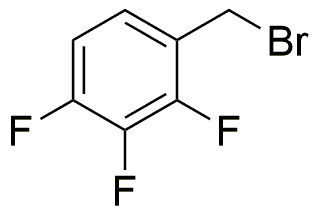2,3,4-Trifluorobenzyl bromide is widely utilized in research focused on:
- Synthesis of Fluorinated Compounds: This chemical serves as a versatile building block in the synthesis of various fluorinated organic compounds, which are valuable in pharmaceuticals and agrochemicals.
- Development of Specialty Polymers: It is used in the production of specialty polymers that exhibit enhanced thermal stability and chemical resistance, making them ideal for high-performance applications in electronics and automotive industries.
- Research in Medicinal Chemistry: The compound plays a crucial role in medicinal chemistry for the development of new drugs, particularly those targeting specific biological pathways due to its unique fluorine substituents that can influence biological activity.
- Fluorinated Materials for Electronics: It is employed in creating fluorinated materials that are essential in the electronics industry, providing improved dielectric properties and stability in various electronic components.
- Environmental Applications: This chemical is also explored in environmental chemistry for the development of new methods for detecting and degrading pollutants, leveraging its unique chemical properties to enhance environmental remediation efforts.
General Information
Properties
Safety and Regulations
Applications
2,3,4-Trifluorobenzyl bromide is widely utilized in research focused on:
- Synthesis of Fluorinated Compounds: This chemical serves as a versatile building block in the synthesis of various fluorinated organic compounds, which are valuable in pharmaceuticals and agrochemicals.
- Development of Specialty Polymers: It is used in the production of specialty polymers that exhibit enhanced thermal stability and chemical resistance, making them ideal for high-performance applications in electronics and automotive industries.
- Research in Medicinal Chemistry: The compound plays a crucial role in medicinal chemistry for the development of new drugs, particularly those targeting specific biological pathways due to its unique fluorine substituents that can influence biological activity.
- Fluorinated Materials for Electronics: It is employed in creating fluorinated materials that are essential in the electronics industry, providing improved dielectric properties and stability in various electronic components.
- Environmental Applications: This chemical is also explored in environmental chemistry for the development of new methods for detecting and degrading pollutants, leveraging its unique chemical properties to enhance environmental remediation efforts.
Documents
Safety Data Sheets (SDS)
The SDS provides comprehensive safety information on handling, storage, and disposal of the product.
Product Specification (PS)
The PS provides a comprehensive breakdown of the product’s properties, including chemical composition, physical state, purity, and storage requirements. It also details acceptable quality ranges and the product's intended applications.
Certificates of Analysis (COA)
Search for Certificates of Analysis (COA) by entering the products Lot Number. Lot and Batch Numbers can be found on a product’s label following the words ‘Lot’ or ‘Batch’.
*Catalog Number
*Lot Number
Certificates Of Origin (COO)
This COO confirms the country where the product was manufactured, and also details the materials and components used in it and whether it is derived from natural, synthetic, or other specific sources. This certificate may be required for customs, trade, and regulatory compliance.
*Catalog Number
*Lot Number
Safety Data Sheets (SDS)
The SDS provides comprehensive safety information on handling, storage, and disposal of the product.
DownloadProduct Specification (PS)
The PS provides a comprehensive breakdown of the product’s properties, including chemical composition, physical state, purity, and storage requirements. It also details acceptable quality ranges and the product's intended applications.
DownloadCertificates of Analysis (COA)
Search for Certificates of Analysis (COA) by entering the products Lot Number. Lot and Batch Numbers can be found on a product’s label following the words ‘Lot’ or ‘Batch’.
*Catalog Number
*Lot Number
Certificates Of Origin (COO)
This COO confirms the country where the product was manufactured, and also details the materials and components used in it and whether it is derived from natural, synthetic, or other specific sources. This certificate may be required for customs, trade, and regulatory compliance.


